|
Related FAQs: Dendrophylliids, Dendrophylliids 2, Dendrophylliid Identification, Dendrophylliid Behavior, Dendrophylliid Compatibility, Dendrophylliid Selection, Dendrophylliid Systems, Dendrophylliid Feeding, Dendrophylliid Disease, Dendrophylliid Reproduction, Stony/True Coral, Coral System Set-Up, Coral System Lighting, Stony Coral Identification, Stony Coral Selection, Coral Placement, Foods/Feeding/Nutrition, Disease/Health, Propagation, Growing Reef Corals, Stony Coral Behavior,
Related Articles: Large Polyp Stony
Corals, Stony or True Corals,
Order Scleractinia, Dyed
Corals,
/The Best Livestock For Your Reef Aquarium:
Pagoda, Sun, Cup Corals and More,
Family Dendrophylliidae, Part 1
Part 2, Part 3,
Part 4
|
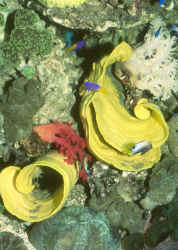
|
|
By Bob Fenner
|
Turbinaria
reniformis
|
Dendrophylliidae: Characteristics of the Family: Most species
lack Zooxanthellae. In fact this family contains the most common
Azooxanthellates species found on reefs. They're either solitary or
colonial, with corallites are mad up of walls that are porous, mainly
filled with coenosteum in life, fused with distinct (Pourtales plan)
septa.
Of the genus with photosynthetic
endosymbiotic algae, Turbinaria often finds its members employed
in ornamental aquatics. As far as ahermatypic species of this family,
only Tubastrea is regularly imported.
Range:
Dendrophylliids are found in tropical and non-tropical regions of the
worlds oceans, some of the ahermatypic, Azooxanthellates ones to a depth
of a 1,500 meters. The genera Turbinaria and Tubastrea
are prominent shallow reef species in large parts of the tropical
Indo-Pacific. Some Dendrophylliids are inconspicuous, but found in the
tropical West Atlantic.
Dendrophylliid Genera You're Not Likely To See: (There
are others); Balanophyllia, Dendrophyllia, Not distinguishable
from very similar Tubastrea without examination of dead skeletal
(septal fusion) characteristics. Eguchipsammia: Mud
dwelling, Azooxanthellates. Heteropsammia...
Genus Balanophyllia: Solitary polyps, calyces appear round in
cross section.
| Balanophyllia floridana, Porous Cup Coral.
Cone-shaped corallite. Polyps individual with twelve prominent septal teeth,
interspersed w/ smaller. Tropical West Atlantic. Curacao, TiffB pic 2015 |
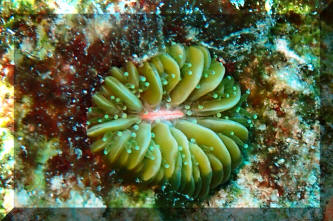
|
| Balanophyllia sp. Either B. hawaiiensis or
B. cf. affinis. Here off Hawai'i's Big Island at night,
though can be found in caves and crevices open during daylight
hours. About one inch in all dimensions. |
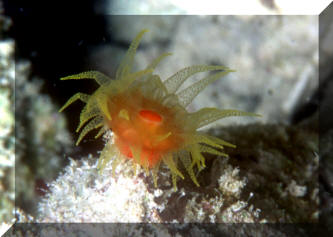
|
Genus Caryophyllia Lamarck 1831: /WA Corals: solitary often
found in deep water but also shallow • attached or embedded in soft substrate •
corallites > 2cm diameter • zooxanthellate
Genus Dendrophyllia de Blainville 1830: Near impossible to distinguish from
Tubastrea w/o microscopic analysis of corallite skeletons.
|
Dendrophyllia arbuscula
Photo by Andrew Kwon (See Dendrophylliid ID
FAQs re)
|
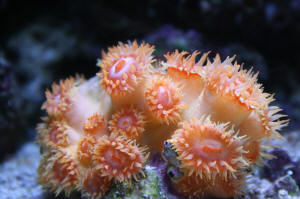
|
|
Dendrophyllia californica Durham, 1947... a
coldwater species. Pic taken at SIO by BobF.
|
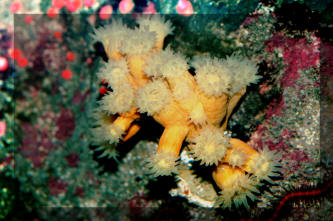
|
| Dendrophyllia sp. Nuka Hiva, Marquesas,
Polynesia at about forty feet, under an overhand during the
day. |
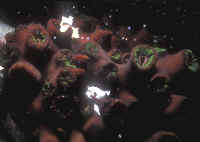
|
Bigger PIX:
The images in this table are
linked to large (desktop size) copies. Click on "framed"
images to go to the larger size. |
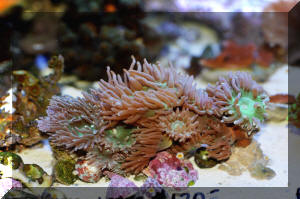 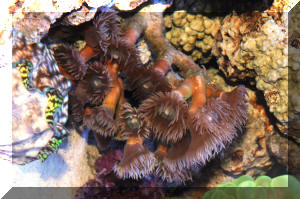
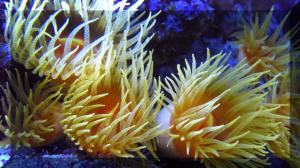 |
Genus Duncanopsamia Wells 1936: One species. /WA Corals:
distinctive tubular corallites • tentacles often extended during the day •
corallites >2.5cm diameter
|
Duncanopsamia axifuga Wells, 1936: Long branching
corallites. Whisker Coral, Australia, PNG, Indonesia. Only rarely
encountered in the wild or the pet-fish interest. At right: in an
aquarium. Below, some Australian pix by PeggyN of
www.all-reef.com
|
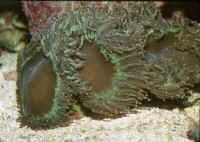
|
Part 2, Part 3,
Part 4

